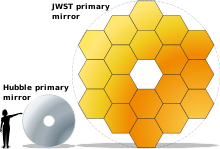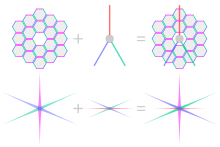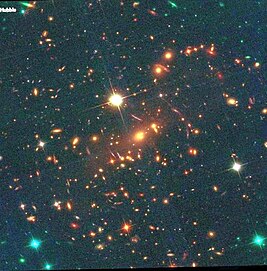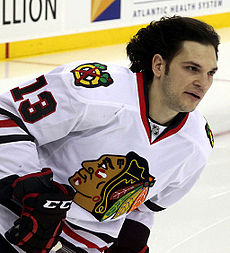웹의 첫번째 깊은 들판
Webb's First Deep Field
웹의 퍼스트 딥 필드는 제임스 웹 우주 망원경(JWST)이 찍은 첫 번째 수술 사진입니다.남반구에서 볼 수 있는 작은 하늘 영역을 덮고 있는 이 딥 필드 사진은 볼란 별자리에 있는 은하단인 SMACS 0723을 중심으로 하고 있습니다.그 이미지에는 수천 개의 은하가 보이는데, 어떤 은하는 130억년이나 된 것도 있습니다.[1]이 사진은 지금까지 촬영된 초기 우주의 가장 높은 해상도의 사진입니다.망원경의 근적외선 카메라(NIRCAM)에 의해 포착된 이 사진은 2022년 7월 11일 NASA에 의해 대중에게 공개되었습니다.
배경
제임스 웹 우주 망원경은 나사가 운영하는 우주 망원경으로 주로 적외선 천문학을 수행하도록 설계되었습니다.2021년 12월 발사된 이 우주선은 2022년 1월부터 지구에서 약 150만km 떨어진 두 번째 태양-지구 라그랑주점(L2)을 중심으로 후광 궤도를 돌고 있습니다.L에서2 태양의 중력은 지구의 중력과 결합하여 지구의 궤도와 일치하는 궤도 주기를 만들고,[2] 지구와 우주선이 함께 태양의 궤도를 돌 때 지구와 태양은 함께 정렬되어 있습니다.
웹의 첫 번째 딥 필드는 망원경의 근적외선 카메라(NIRCAM)에 의해 촬영되었으며, 다양한 파장의 이미지로부터 생성된 합성물로 총 12.5시간의 노출 시간입니다.[3][4]
SMACS 0723은 지구의 남반구에서 보이는 은하단이며,[5] 깊은 과거를 찾기 위해 허블과 다른 망원경들에 의해 자주 조사되어 왔습니다.[2]
과학적 결과
이 이미지는 46억 년 전에 나타났던 은하단 SMACS 0723을 보여주는데,[4] 팔 길이의 모래알과 거의 같은 각진 크기의 하늘 영역을 덮고 있습니다.[3]이미지 속의 많은 물체들은 빛이 방출하는 극도의 거리에 걸쳐 공간의 확장으로 인해 눈에 띄는 적색편이를 겪었습니다.[6]현재까지 측정된 적색편이는 거의 200개에 달하며,[7] 적색편이가 가장 높은 곳은 8.498개입니다.[8]
은하단의 결합된 질량은 중력 렌즈의 역할을 하며 훨씬 더 먼 은하단 뒤의 이미지를 확대하고 왜곡합니다.웹의 NIRCAM은 성단과 확산되는 특징을 포함하여 이전에 볼 수 없었던 작고 희미한 구조를 드러내며 먼 은하계들을 예리한 초점으로 이끌었습니다.[3]
사진의 회절 스파이크


사진 속의 점광원 주위에 있는 여섯 개의 밝은 스파이크와 두 개의 희미한 스파이크는 망원경의 물리적 한계에 의해 만들어진 인공물입니다.6개의 밝은 스파이크들은 거울의 가장자리로부터의 회절의 결과입니다.거울은 18개의 개별 유닛으로 구성되어 있고, 각각은 보통의 육각형 모양을 하고 있습니다.망원경의 큰 거울을 구성하는 단위체들의 육각형 테두리는 여섯 개의 뾰족한 모양을 만들어냅니다.[9]원형 거울/렌즈가 있는 망원경에는 이러한 스파이크가 없습니다. (스파이크 대신 원형 테두리에서 회절하면 에어리 디스크라고 불리는 동심원 고리 패턴이 생성됩니다.).
두 개의 추가적인 스파이크는 망원경의 보조 거울을 메인 거울 앞에 고정하고 있는 지주대의 회절 결과입니다.오른쪽 그림에서 볼 수 있듯이, 세 개의 스트럿에서 발생하는 회절은 여섯 개의 스파이크를 생성하지만, 이 중 네 개는 림에서 발생한 회절에서 생성된 스파이크와 함께 정렬되도록 설계되었습니다.이것은 사진에서 두 개의 희미한 수평 스파이크를 보이게 합니다.[10]
의의
가장 깊은 우주의 모습
2022년 7월 12일, JWST는 지금까지 우주의 가장 깊은 선명한 적외선 이미지를 전달했습니다.[11]웹의 First Deep Field는 JWST의 첫 번째 전체 거짓 색상 이미지이며,[12] 지금까지 촬영된 우주의 가장 높은 해상도의 적외선 시야입니다.[11]이 이미지는 우주의 아주 작은 조각에 있는 수천 개의 은하를 보여주는데, 웹의 날카로운 근적외선 시야는 극도로 먼 은하에 있는 희미한 구조물을 끌어내어 현재까지 초기 우주를 가장 상세하게 볼 수 있습니다.지금까지 적외선으로 관측된 것들 중 가장 희미한 것들을 포함한 수천 개의 은하들이 웹의 시야에 처음으로 나타났습니다.[13][3]
2022년 7월 11일 조 바이든 미국 대통령에 의해 열린 한 행사에서 처음 공개되었습니다.[2]
허블우주망원경과의 비교
다음 이미지는 허블 우주 망원경이 찍은 이미지와 같은 은하단의 웹이 찍은 이미지를 비교한 것입니다.
참고 항목
참고문헌
- ^ "Webb's First Deep Field (NIRSpec MSA Emission Spectra)". WebbTelescope.org. Retrieved 14 July 2022.
- ^ a b c Overbye, Dennis; Chang, Kenneth; Tankersley, Jim (11 July 2022). "Biden and NASA Share First Webb Space Telescope Image". The New York Times. ISSN 0362-4331. Archived from the original on 12 July 2022. Retrieved 12 July 2022.
- ^ a b c d Garner, Rob (11 July 2022). "NASA's Webb Delivers Deepest Infrared Image of Universe Yet". NASA. Archived from the original on 11 July 2022. Retrieved 11 July 2022.
- ^ a b "Webb's first deep field". European Space Agency. 12 July 2022. Archived from the original on 12 July 2022. Retrieved 11 July 2022.
- ^ "SRELICS". IRAS. Archived from the original on 12 July 2022. Retrieved 12 July 2022.
- ^ Isaacs-Thomas, Isabella (11 July 2022). "Here's the deepest, clearest infrared image of the universe ever produced". PBS. Archived from the original on 12 July 2022. Retrieved 12 July 2022.
- ^ Noirot, Gaël; Desprez, Guillaume; Asada, Yoshihisa; Sawicki, Marcin; Estrada-Carpenter, Vicente; Martis, Nicholas; Sarrouh, Ghassan; Strait, Victoria; Abraham, Roberto; Bradač, Maruša; Brammer, Gabriel; Iyer, Kartheik; MacFarland, Shannon; Matharu, Jasleen; Mowla, Lamiya (2023). "The first large catalogue of spectroscopic redshifts in Webb's first deep field, SMACS J0723.3−7327". Monthly Notices of the Royal Astronomical Society. 525 (2): 1867–1884. arXiv:2212.07366. doi:10.1093/mnras/stad1019.
- ^ Carnall, A. C.; Begley, R.; McLeod, D. J.; Hamadouche, M. L.; Donnan, C. T.; McLure, R. J.; Dunlop, J. S.; Milvang-Jensen, B.; Bondestam, C. L.; Cullen, F.; Jewell, S. M.; Pollock, C. L. (9 November 2022). "A first look at the SMACS0723 JWST ERO: spectroscopic redshifts, stellar masses and star-formation histories". Monthly Notices of the Royal Astronomical Society: Letters. 518 (1): L45–L50. arXiv:2207.08778. doi:10.1093/mnrasl/slac136. ISSN 1745-3925.
- ^ Williams, Matt (19 March 2022). "Wondering About the 6 Rays Coming out of JWST's Test Image? Here's why They Happen". Universe Today. Archived from the original on 16 July 2022. Retrieved 15 July 2022.
- ^ "Webb's Diffraction Spikes".
- ^ a b Garner, Rob (11 July 2022). "NASA's Webb Delivers Deepest Infrared Image of Universe Yet". NASA. Retrieved 17 July 2023.
- ^ Strickland, Ashley (11 July 2022). "President Biden reveals the James Webb Space Telescope's stunning first image". CNN. Archived from the original on 12 July 2022. Retrieved 12 July 2022.
- ^ Chow, Denise (11 July 2022). "The Webb telescope's first full-color photo is here – and it's stunning". NBC News. Archived from the original on 12 July 2022. Retrieved 11 July 2022.
- ^ Garner, Rob (11 July 2022). "NASA's Webb Delivers Deepest Infrared Image of Universe Yet". NASA. Archived from the original on 12 July 2022. Retrieved 12 July 2022.
- ^ Overbye, Dennis; Chang, Kenneth; Tankersley, Jim (11 July 2022). "Biden and NASA Share First Webb Space Telescope Image – From the White House on Monday, humanity got its first glimpse of what the observatory in space has been seeing: a cluster of early galaxies". The New York Times. Archived from the original on 12 July 2022. Retrieved 12 July 2022.
- ^ Pacucci, Fabio (15 July 2022). "How Taking Pictures of 'Nothing' Changed Astronomy - Deep-field images of "empty" regions of the sky from Webb and other space telescopes are revealing more of the universe than we ever thought possible". Scientific American. Retrieved 16 July 2022.
- ^ Deliso, Meredith; Longo, Meredith; Rothenberg, Nicolas (14 July 2022). "Hubble vs. James Webb telescope images: See the difference". ABC News. Retrieved 15 July 2022.
- ^ Kooser, Amanda (13 July 2012). "Hubble and James Webb Space Telescope Images Compared: See the Difference - The James Webb Space Telescope builds on Hubble's legacy with stunning new views of the cosmos". CNET. Retrieved 16 July 2022.
- ^ Atkinson, Nancy (2 May 2022). "Now, We can Finally Compare Webb to Other Infrared Observatories". Universe Today. Archived from the original on 10 May 2022. Retrieved 12 May 2022.
- ^ Chow, Denise; Wu, Jiachuan (12 July 2022). "Photos: How pictures from the Webb telescope compare to Hubble's - NASA's $10 billion telescope peers deeper into space than ever, revealing previously undetectable details in the cosmos". NBC News. Retrieved 16 July 2022.







